1996 PONTIAC GRAND-AM service indicator
[x] Cancel search: service indicatorPage 112 of 356

Charging System Indicator Light
The charging system
indicator light will come on
briefly when
you turn on the
ignition, but the engine
is
not running, as a check to
show you it is working.
Then it should go out. .. 1.
. I -1
If it stays on when your engine is running, OF comes on
while you are driving, you may have a problem with the
electrical charging system. It could indicate that you
have a loose generator drive belt or another electrical
problem. Have it checked right away. Driving while this
light
is on could drain your battery.
If you mast drive a short distance with the light on, be
certain to turn off all your accessories, such as themdio
and
air conditioner,
Brake System Warning Light
Your Pontiac’s hydraulic brake system is divided into
two parts. If one part isn’t working, the other part can
still w’ork and
stop you. For good braking, though, you
need both
parts workmg well.
If the warning light comes on, there could be a brake
problem. Have your brake system inspected right away.
BRAKE
This light should come ow
briefly when you turn the
ignitibn key
to RUN. If it
doesn’t come on then, have
it fixed so it will be ready to
warn
you if there’s a
problem,
If the light .comes on while you are driving, pull off the
road and stop carefully. You may notice that the pedal is
harder to push. Or, the pedal may go closer to the floor,
It may take longer to stop. If the light is still on, have the
vehicle towed €or
service, (See “Towing Your Vehicle”
in the Index.)
2-56
ProCarManuals.com
Page 116 of 356

Low Coolant Warning Light
; I’ ,.
If this light comes on and
stays on, the vehicle should
be promptly pulled
off the
road and the coolant level
checked.
See “Engine
Coolant”
in the Index.
Malfunctilon Indicator Lamp
(Check Engine Light) ~ ..
0
CHECK
Your Pontiac is equipped
with a computer
which
monitors operation of the
fuel, ignition and emission
control systems.
If there are visible signs of steam see “Engine
Overheating” in the
Index before opening the hood. , . ’? --+ -- This system is called OBD I1 (On-Board .>. ’ I .;: . , Diagnostics-Second Generation) and is intended to
.-. . assure that emissions are at acceptable levels for the
life of the vehicle, helping to produce a cleaner
environment.
(In! Canada, OBD 11 is replaced by
Enhanced Diagnostics.) The CHECK ENGINE light
comes on to indicate that there is a problem and service
is required, Malfunctions often will
be indicated by the
system before
any problem is apparent, which may
prevent more serious damage to your vehicle. This
system is
also designed to assist your service technician
d . in correctly diagnosing any malfunction.
.. .? ’. .. .- . .. i - ,, , c < -. , ,. t :. . ‘7 -n. 9’ .! , . ‘i :- -:x: :, -’ ::;.- . b- .. ,- , . .. .. . : .. -. I. . :. ‘1 .’ ’ E -, . - . r_ :. .. . I. , I -.. . I .C . .. . . .. . .-..-‘ >: =: , , ‘. .. -; T‘.
’ ““2-60
ProCarManuals.com
Page 121 of 356

Passlock Warning Light Fuel Gage
THEFT
SYS
This light will come on
briefly when you turn the
key towards the START
position. The light will stay
on until the engine starts.
W
(3
Your fuel gage tells you
about how much fuel you
have left, when
the ignition is
on. When the indicator nears
EMPTY (E), you still have a
little fuel left, but you should
get more soon.
An amber
light
will come on below the
gage when the fuel
tank is
near
EMPTY (E).
If the light flashes,. the Passlock system has entered a
tamper mode. If the vehicle fails to start, see "Passlock"
in the Index.
If the light comes on continuously while driving and
stays on, there may
be a problem with the Passlock
system. Your vehicle will not be protecteil
by Passlock,
and you should see your dealer.
J
Here are four things that some owners ask about. None
of these show a problem with
your fuel gage:
At the service station, the gas pump shuts off b'efore
the gage reads
FULL (F). ' I
It takes a little more or less fuel to fill up than the gage
indicated. For example,
the gage may have indicated
the
tank was half full, but it actually took a little more
' or less than half the tank's capacity to fill the tank.
The gage moves a little when you turn a, corner or
The gage doesn't go back to EMPTY (E) when you
speed up.
turn
off the ignition.
2-65
ProCarManuals.com
Page 147 of 356
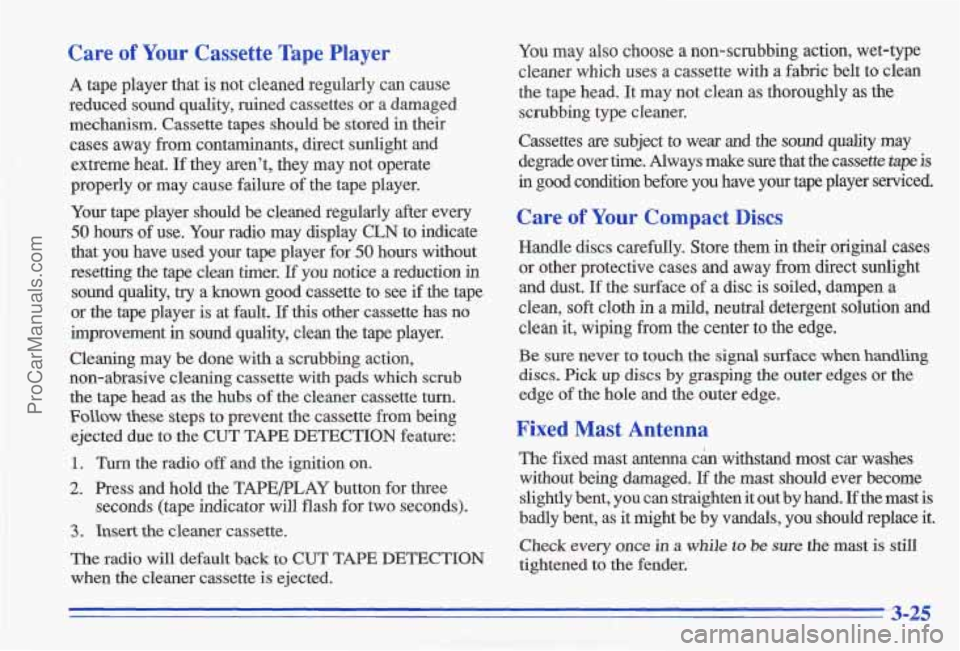
Care of Your Cassette Tape Player
A tape player that is not cleaned regularly can cause
reduced sound quality, ruined cassettes or a damaged
mechanism. Cassette tapes should be stored in their
cases away from contaminants, direct sunlight and
extreme heat.
If they aren’t, they may not operate
properly or may cause failure
of the tape player.
Your tape player should be cleaned regularly after every
50 hours of use. Your radio may display CLN to indicate
that you have used your tape player for
50 hours without
resetting the tape clean timer. If you notice a reduction in sound quality,
try a known good cassette to see if the tape
or the tape player is at fault. If this other cassette has no
improvement
in sound quality, clean the tape player.
Cleaning may
be done with a scrubbing action,
non-abrasive cleaning cassette with pads which scrub
the tape head
as the hubs of the cleaner cassette turn.
Follow these steps to prevent the cassette from being
ejected due to the CUT TAPE DETECTION feature:
1. Turn the radio off and the ignition on.
2. Press and hold the TAPEPLAY button for three
3. Insert the cleaner cassette.
The radio will default back
to CUT TAPE DETECTION
when the cleaner cassette is ejected.
seconds (tape indicator will flash
for two seconds).
You may also choose a non-scrubbing action, wet-type
cleaner which uses a cassette with a fabric belt to clean
the tape head.
It may not clean as thoroughly as the
scrubbing type cleaner.
Cassettes
are subject to wear and the sound quality may
degrade over time. Always make sure that the cassette
tape is
in good condition before you have your tape player serviced.
Care of Your Compact Discs
Handle discs carefully. Store them in their original cases
or other protective cases and away from direct sunlight
and dust.
If the surface of a disc is soiled, dampen a
clean, soft cloth in a mild, neutral detergent solution and
clean it, wiping from the center to the edge.
Be sure never to touch
the signal surface when handling
discs.
Pick up discs by grasping the outer edges or the
edge of the hole and the outer edge.
Fixed Mast Antenna
The fixed mast antenna cb withstand most car washes
without being damaged.
If the mast should ever become
slightly bent, you can straighten it out by hand.
If the mast is
badly bent, as it might be by vandals, you should replace it.
Check every once
in a while to be sure the mast is still
tightened to the fender.
3-25
ProCarManuals.com
Page 224 of 356
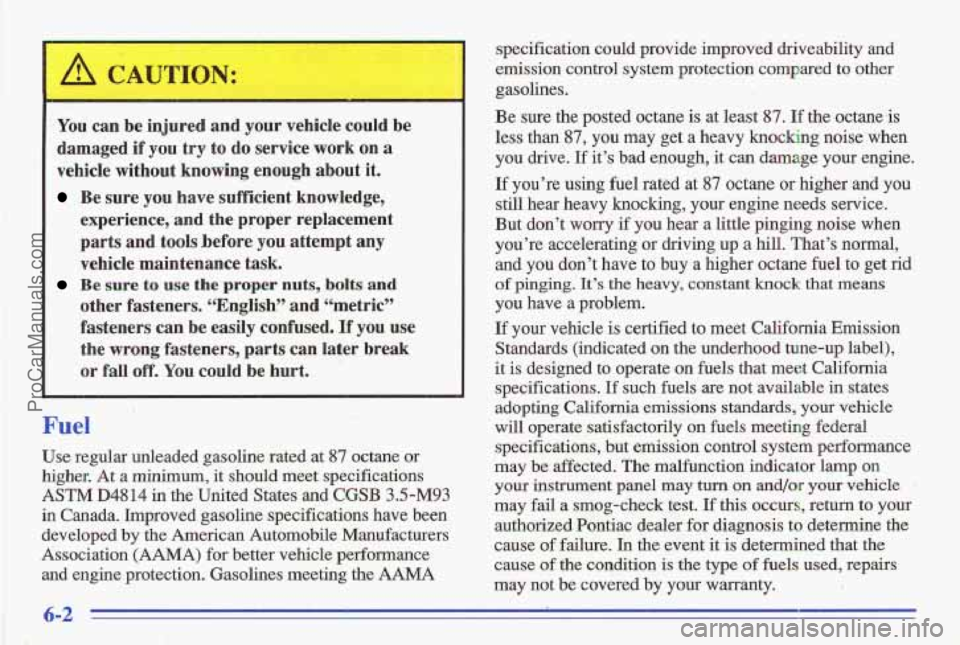
A CAUTION:
You can be injured and your vehicle could be
damaged if you try to do service work on a
vehicle without knowing enough about it.
Be sure you have sufficient knowledge,
experience, and the proper replacement
parts and tools before you attempt any
vehicle maintenance task.
Be sure to use the proper nuts, bolts and
other fasteners. “English” and “metric”
fasteners can be easily confused. If
you use
the wrong fasteners, parts can later break
or fall off. You could be hurt.
,, ~
Fuel
Use regular unleaded gasoline rated at 87 octane or
higher.
At a minimum, it should meet specifications
ASTM D4814 in the United States and CGSB 3.5-M93
in Canada. Improved gasoline specifications have been
developed by the American Automobile Manufacturers
Association
(AAMA) for better vehicle performance
and engine protection. Gasolines meeting the AAMA specification could provide improved driveability and
emission control system protection compared to other
gasolines.
Be ,sure the posted octane
is at least 87. If the octane-is
less
than 87, you may get a heavy knocking noise when
you drive. If it’s bad enough, it can damage your engine.
If you’re using fuel rated at 87 octane or higher and you
still hear heavy knocking, your’engine needs service.
But don’t worry if you hear a little pinging noise when
you’re accelerating
or driving up a hill. That’s normal,
and you don’t have to buy a higher octane fuel to get rid
of pinging. It’s the heavy, constant knock that means
you have a problem.
If your vehicle is certified to meet California Emission
Standards (indicated on
the underhood tune-up label),
it is designed to operate
on fuels that meet California
specifications. If such fuels
are not available in states
adopting California
emissions standards, your vehicle
will operate satisfactorily
on fuels meeting federal
specifications, but emission control system performance
may be affected. The malfunction indicator lamp
on
you instrument panel may turn on and/or your vehicle
may fail a smog-check test.
If this occurs, return to your
authorized Pontiac dealer for diagnosis to determine the
cause of failure.
In the event it is determined that the
cause
sf the condition is the type of fuels used, repairs
may not be covered
by your warranty.
ProCarManuals.com
Page 225 of 356
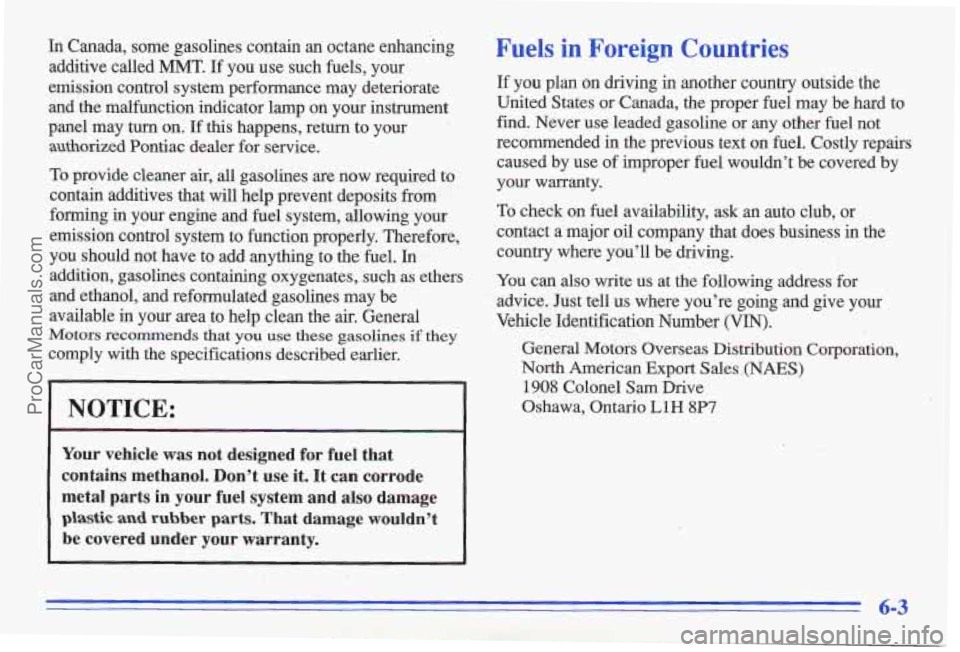
In Canada, some gasolines contain an octane enhancing additive called MMT.
If you use such fuels, your
emission control system performance may deteriorate and the malfunction indicator lamp on your instrument
panel may turn
on. If this happens, return to your
authorized
Pontiac dealer for service.
To provide cleaner air, all gasolines are now required to
contain additives that will help prevent deposits from
forming in your engine and fuel system, allowing your
emission control system to function properly. Therefore,
you should not have to add anything to the fuel.
In
addition, gasolines containing oxygenates, such as ethers
and ethanol, and reformulated gasolines may be
available
in your area to help clean the air. General
Motors recommends that you use these gasolines if they
comply with the specifications described earlier.
NOTICE:
Your vehicle was not designed for fuel that
contains methanol. Don’t use it. It can corrode
metal parts in your fuel system and also damage
plastic and rubber parts. That damage wouldn’t
be covered under your warranty.
Fuels in Foreign Countries
If you plan on driving in another country outside the
United States or Canada, the proper fuel may be hard to
find. Never use leaded gasoline
or any other fuel not
recommended in the previous text on fuel. Costly repairs
caused by use of improper fuel wouldn’t be covered by
your warranty.
To check on fuel availability, ask an auto club, or
contact a major oil company .that does business
in the
country where you’ll be driving.
You can also write us at the following address for
advice. Just tell us where you’re going and give your
Vehicle Identification Number
(VIN).
General Motors Overseas Distribution Corporation,
North American Export Sales .(NAES)
1908 Colonel Sam Drive
Oshawa, Ontario
L1H 8P7
ProCarManuals.com
Page 252 of 356
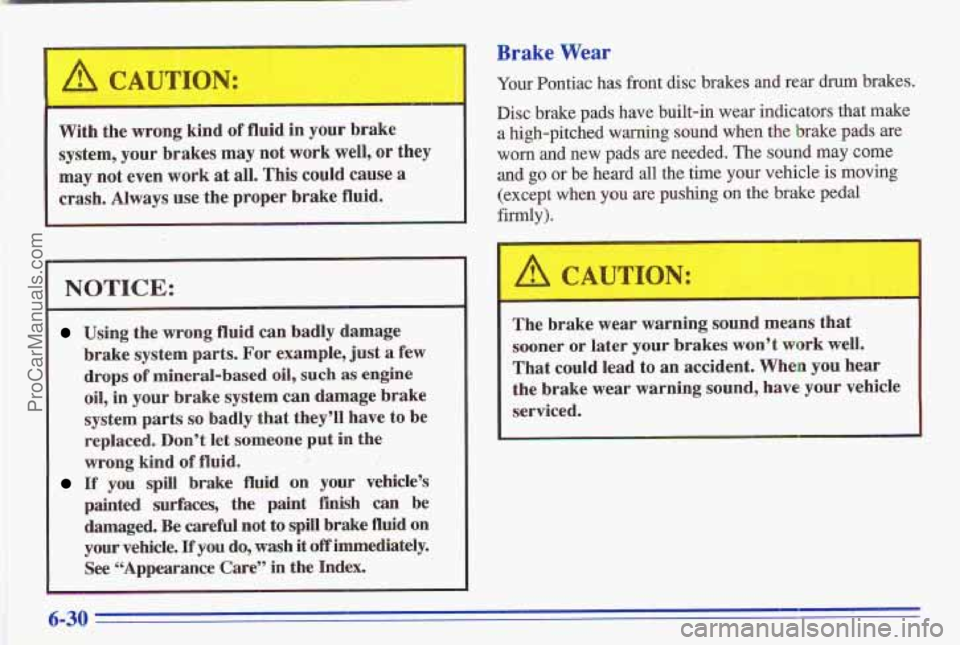
With the wrong kind,of fluid in your brake
system, your brakes
may not work well, or they
may not even work
at all, This could cause a
crash. Always use the moper brake fluid.
NOTICE:
Using the wrong fluid can badly damage
brake system park.
For example, just a few
drops
of mineral-based oil, such as engine
oil, in your brake system can damage brake
system
parts so badly that they’ll have to be
replaced. Don’t
let someone put in the
wrong kind of fluid.
If you spill brake fluid on your vehicle’s
painted surfaces, the paint
finish can be
damaged. Be careful not to spill brake fluid on
your vehicle, If you do, wash it off immediately.
See “Appearance Care” in
the Index.
i ‘I I .- ’;/
Brake Wear
Your Pontiac has front disc brakes and sear drum brakes.
Disc brake pads have built-in wear indicators that make
a high-pitched warning sound whew the brake pads are
worn and new pads are needed. The sound may come
and go or be heard all the time your vehicle is moving
(ex’cept when
you are pushing on.the brake pedal
firmly).
The brake wear warning sound means that
sooner
or later your brakes wonY work well.
That could lead
to an accident. When you hear
the brake wear warning sound, have your vehicle
serviced.
6-30
ProCarManuals.com
Page 262 of 356
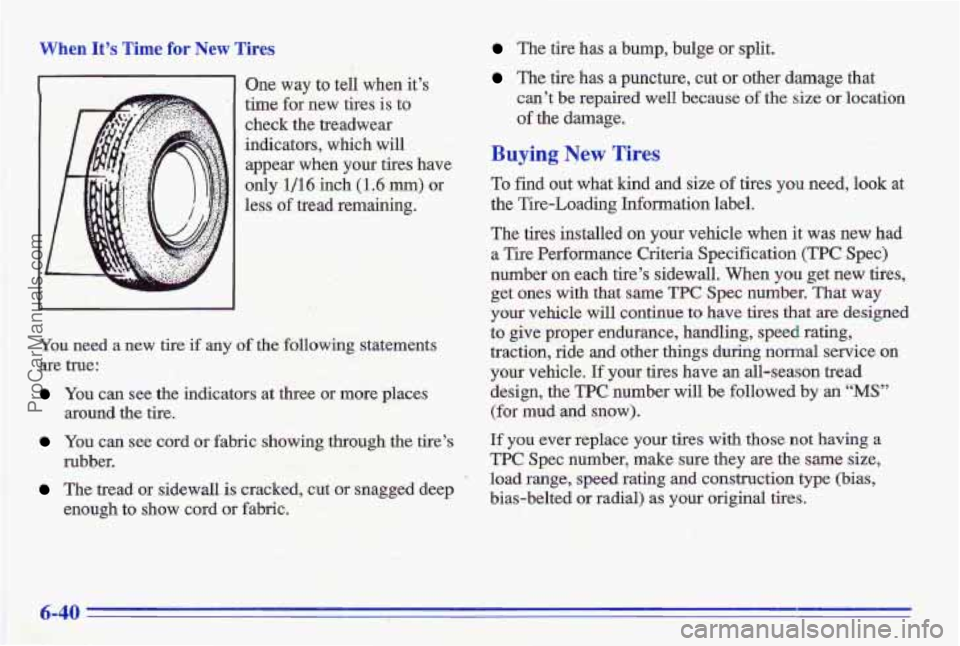
When It’s Time for New Tires
I One wav to tell when it’s
time
fcinew tiies is to
check the treadwear
indicators, which will
,.
appear when your tires have
only 1/16 inch (1.6 rrim) or
less
of tread remaining.
I
You need a new tire if any of the following statements
are true:
, 1, .” ! , .
You cdsee the indicators at three or more places
.. .. . . (. , ;.--.-$ _. . .I :: , L. -. , &&&
-. .. . .I , .I 1 -
around the tire.
You can see cord or fabric showing through the tire’s
The tread or sidewall is cracked, cut or snagged deep
rubber.
enough to
show cord or fabric.
The tire has a bump, bulge or split.
The tire h’as a puncture, cut or other damage that
can’t be repaired
well because of the size or lo’cation
of the damage.
Buying New Tires
To find out what kind and size of tires you need, look at
the Tire-Loading Information label.
The
tires installed on your vehicle when it was new had
a Tire Performance Criteria Specification (TPC Spec)
number
on each tire’s sidewall. When you get new tires,
get ones with that same
TPC Spec number. That way
your vehicle will continue to have tires that are designed
to give proper endurance, handling, speed rating,
traction, ride
and other thing’s during normal service on
your vehicle. If your tires have an all-season tread
design, the
TPC number will be followed by an “MS”
(for mud and snow).
If you ever replace your tires with those not having a
TPC Spec nuhber, make sure they are the same size,
load
range, speed rating &d construction type (bias,
bias-belted
or radial) as your original tires.
..
6-40
ProCarManuals.com